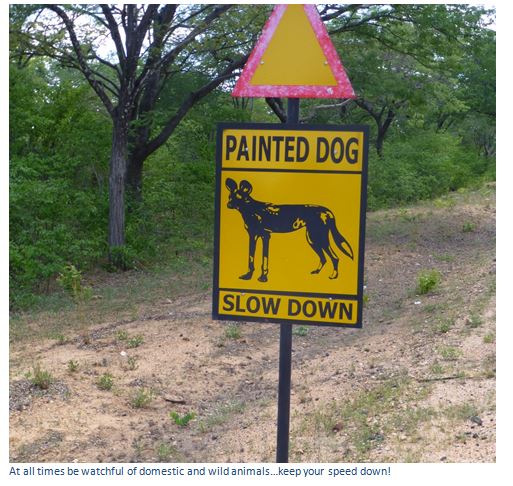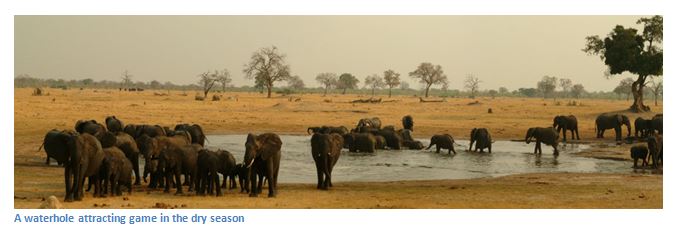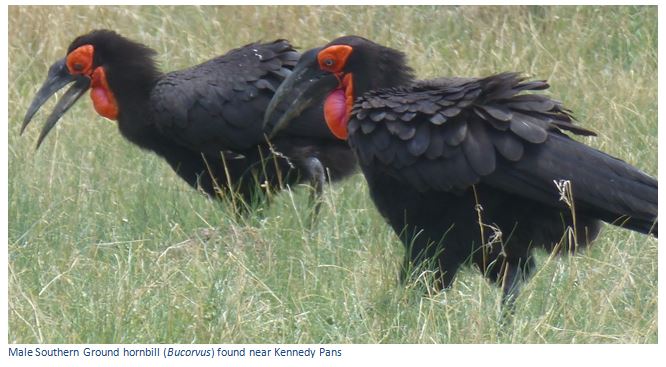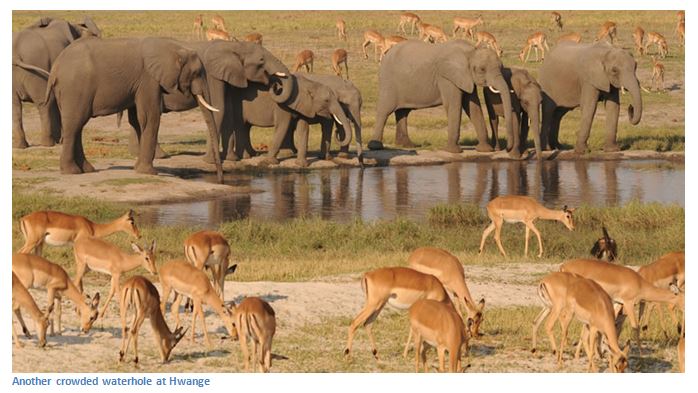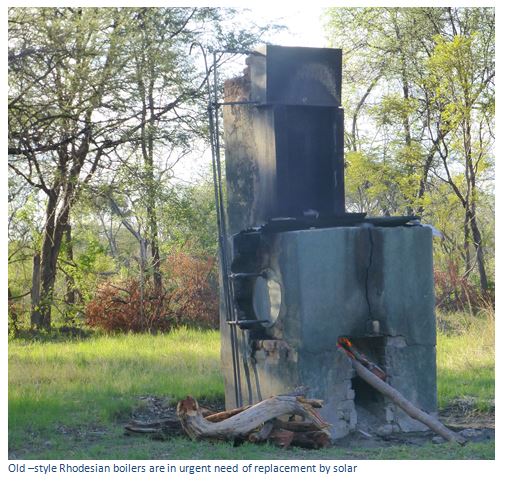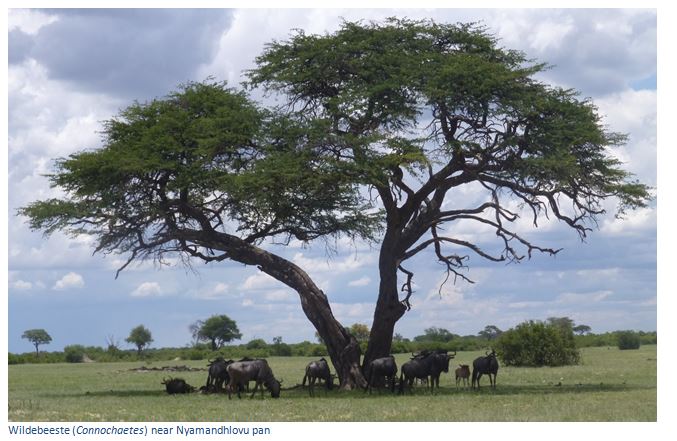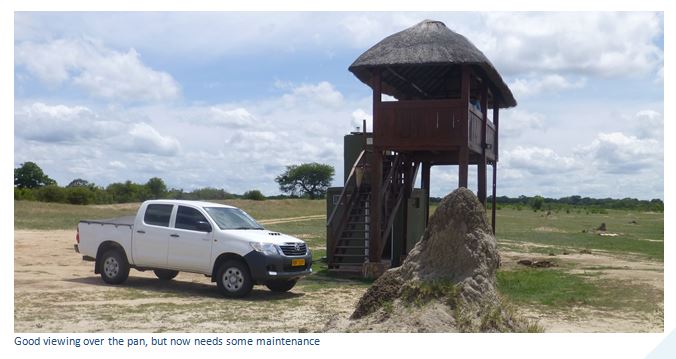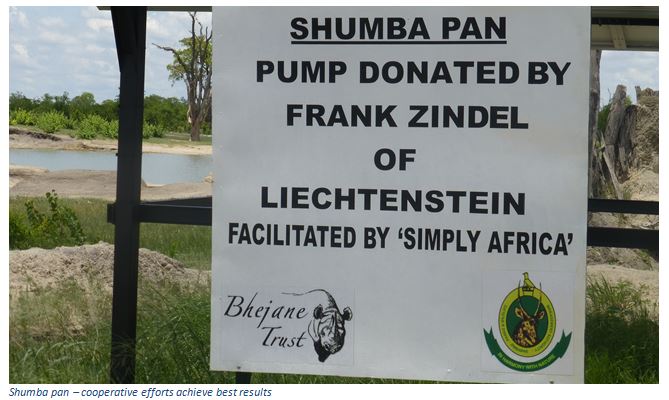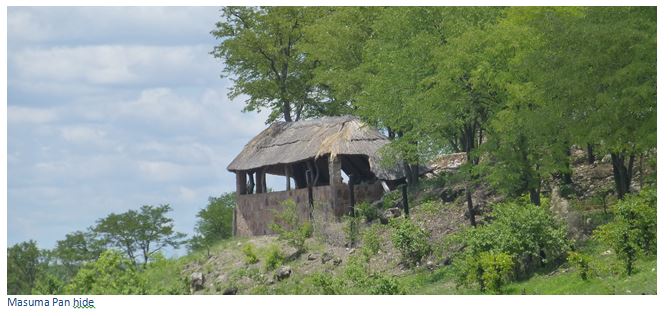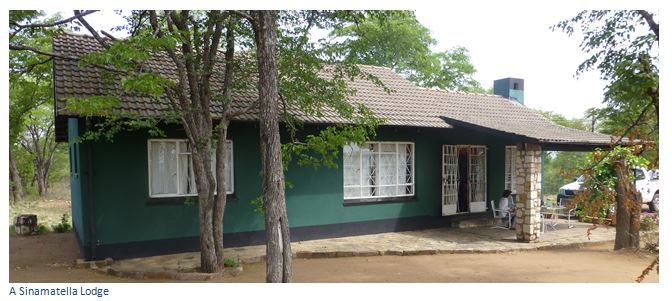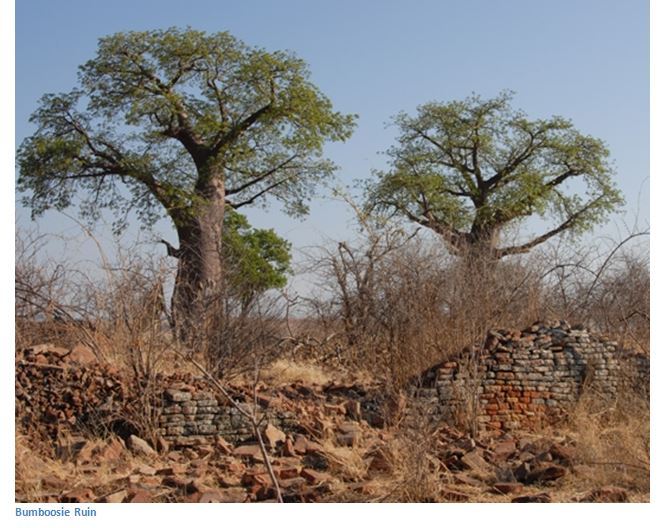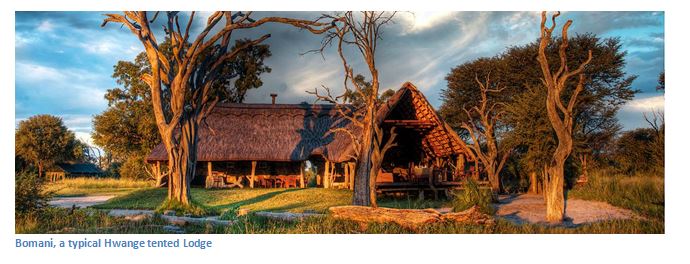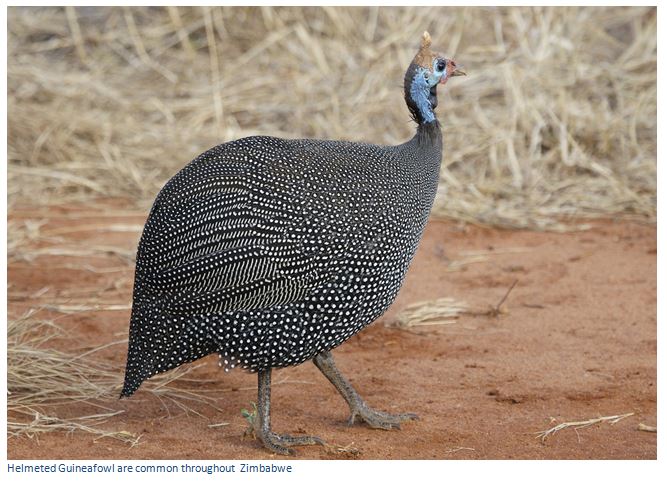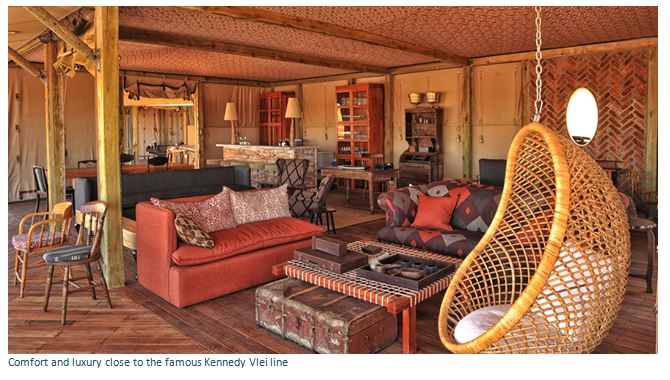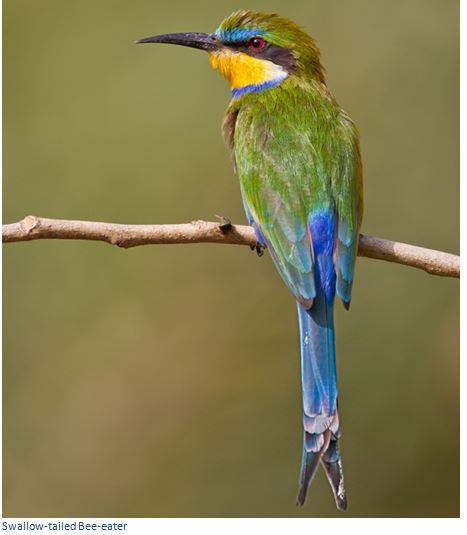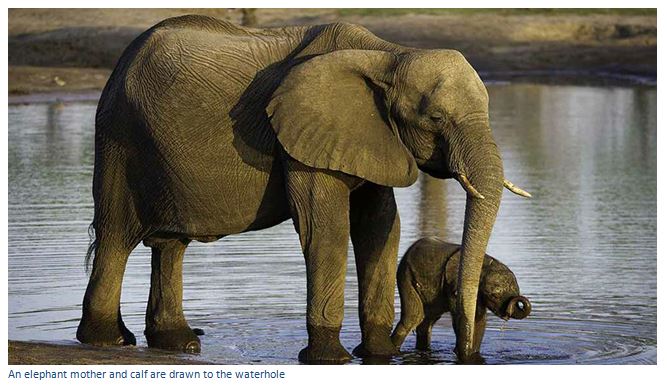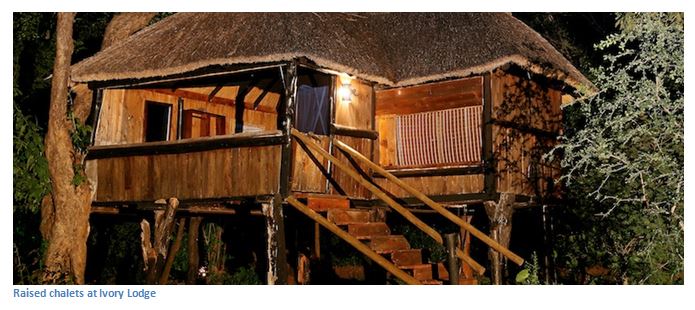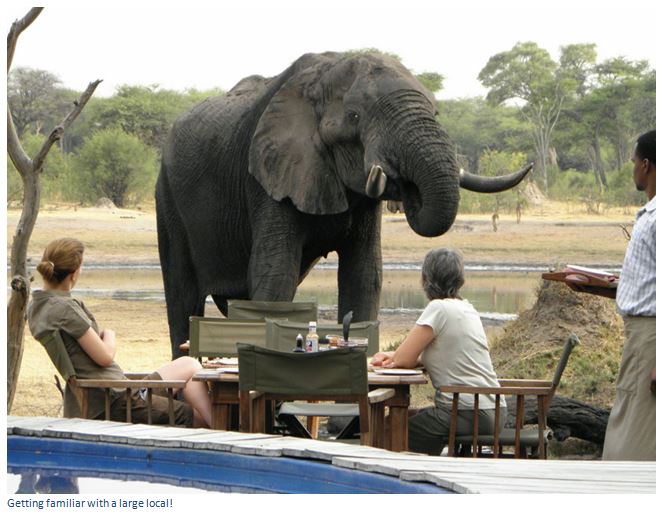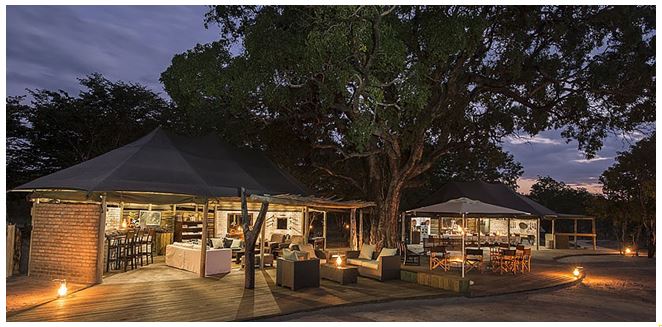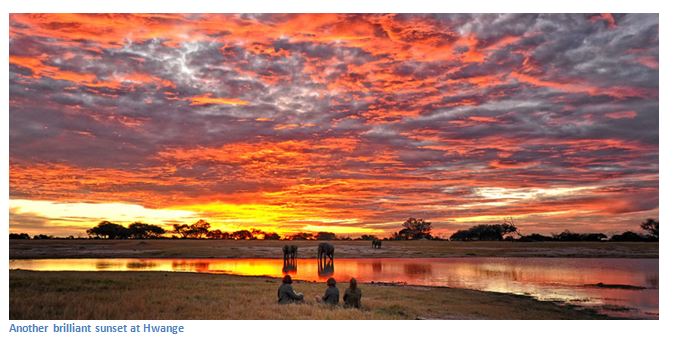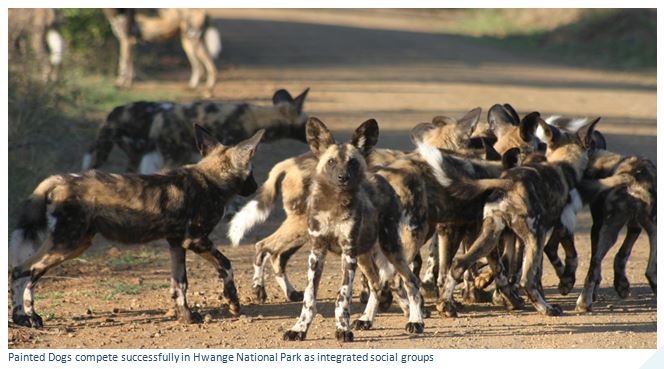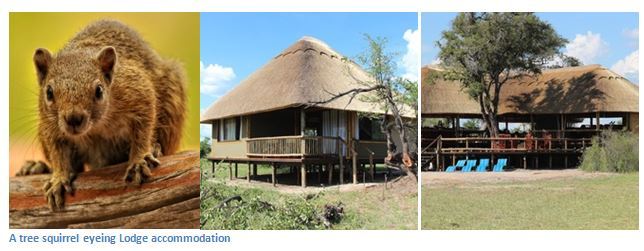Hwange National Park
- Apart from being the largest of Zimbabwe’s National Parks, Hwange is easy to reach either from Victoria Falls or Bulawayo on the A8 national road.
- Although the Park has good infrastructure, visitors will not find half a dozen minibuses in zebra pattern camouflage filled with tourists crowding around the only lion! It’s a wilderness with some of the best game viewing to be experienced anywhere in Africa, yet so few tourists in comparison.
- Due to its huge size, there is considerable diversity of habitats for animals and over 100 species of mammals including the "Big 5" i.e. elephant, rhino, buffalo, lion and leopard are also found in Hwange National Park and over 400 species of birds can be found here. The elephants of Hwange are world famous with an estimated half of Zimbabwe’s eighty thousand elephants here.
- Prime spots are Masuma Dam and its thatched hide, Ngweshla and Guvalala platform on tall stilt legs overlooking a waterhole. Best game viewing is from July to October.
The National (A8) road from Bulawayo is generally in good condition with some bumpy parts near Bulawayo, but smooth tar thereafter.
Main Camp turn-off is at the 264.5 kilometre peg on the (A8) Bulawayo-Victoria Falls Road. From here a tar road (15 kilometres) leads to the Park boundary at the railway crossing, a short distance from Main Camp.
Sinamatella Camp is reached from Main Camp by a narrow tar that is in poor condition necessitating driving on either verge for much of the time, then a good and well-graded gravel road. Another way is to take the good gravel road that turns off the (A8) Bulawayo - Victoria Falls Road just south of the town of Hwange. Sinamatella Camp is reached 45 kilometres further on via Mbala Lodge in the Deka Safari Area.
Robins Camp is reached by a gravel road that turns off the (A8) Bulawayo - Victoria Falls Road 48 kilometres south of Victoria Falls. From here it is approximately 70 kilometres to Robins Camp and en route there is a turn off to Matetsi Safari Area headquarters and to Pandamatenga. Robins Camp can also be reached by road through the National Park from Main Camp and Sinamatella during the dry season.
It is usually possible from May to October to enter the Park by any designated access road and to drive to any of the camps. During the wet season though, advice should be sought as to the best routes and the visitor reception at each camp will provide advice on the many game-viewing drives of the 480 kilometres of road system as they may deteriorate. The tar roads within the National Park are in moderate to poor condition and there are few routes considering the vastness of the Park.
Main Camp has unlicensed airstrip for private/ charter aircraft, but prior permission to land must be obtained from Main Camp and there are no hangars. Hwange has a licensed Airport.
One of the best-known protected areas in Zimbabwe is Hwange National Park. This Park is also the largest in the country covering more than 14,600 square kilometres (5,863 square miles) or 1,460,000 hectares and the easiest to reach, both from Victoria Falls and from Bulawayo. Filled with large concentrations of game, a plethora of birdlife and a diverse variety of habitats, Hwange National Park is a great Game Park. However it is in this condition thanks to some very dedicated people – volunteers, conservationists, non-profit organizations such as Friends of Hwange Trust and Save Hwange Trust who have donated fuel and equipment to keep the boreholes running; as well as the dedicated staff and efforts of volunteers that the wild animals remain. Poachers backed by powerful backers and foreign interests have tried their best; but have not succeeded, although in 2013 over 300 elephants were deliberately killed with cyanide.
For true nature lovers and for those who want to spend a few days deep in the wilderness, Hwange National Park is the place to go. A tented camp under the African stars and walking with Rangers in the wilderness in search of wild animals, birds, tracks and interesting trees provides an intense experience of nature and its wonders. There are no rivers that carry water all year round, thus in the dry season from about May to November the animals depend on the water points at which water is artificially pumped for them.
John Brebner commented after the 2015 National Park game count on the lack of water at Hwange, mainly in the Main Camp area. Unfortunately, National Parks are not providing much diesel and most, if not all, the fuel to pump water for the animals is currently being provided by sponsorship and donations collected by Friends of Hwange Trust, with some help from WEZ Matabeleland, Bhejane Trust and some of the surrounding concessions.
The Friends of Hwange newsletter of March 2016 reported considerable progress in installing new solar water pumps as they continue to decrease the National Park’s dependency on diesel engines. This process takes place because the diesel engines are expensive to run and maintain, and secondly, they are not eco-friendly. Their advantage is that they do pump water 24/7, even during winter when water is short; while solar can only pump water during 10 or so daylight hours. They have also replaced a number of windmills which are all getting old and expect to install at least ten new solar pump systems this year.
Gary, employed by FOH, has to do the majority of the work with the pumps and engine units as well as refuel them. He works closely with the National Parks team and has a very good working relationship with them, but there is little point sitting back and complaining about management inertia, as nothing is going to change. If visitors want to continue to enjoy visits to Hwange National Park and the stunning array of creatures and flora it can offer, they must support local organisations, see their website www.friendsofhwange.com) to see what they are currently doing. For a small donation, there is a lovely new map of Hwange with fabulous pictures and a write up available from John Brebner at Acol in Bulawayo, or from Dave Dell in Harare.
While the park abounds in elephant population (one of the largest in the world), it also hosts 100 mammal species, including nineteen large herbivores and eight large carnivores and 400 bird species; Zimbabwe's specially protected animals are all found here. Gemsbok, brown hyena and the population of African wild or painted dogs is stated to be of one of the largest surviving groups in Africa now.
The name derives from a local chief named Hwange and in the nineteenth Century Mzilikazi, King of the Ndebele used the area as his hunting territory. Farmers then attempted to breed cattle, but the lack of water and nagana disease spread by tsetse flies and large numbers of lions made life difficult for cattle ranching. A large part of the present Park were turned into a Wildlife Reserve in 1928 and in 1949 when the cattle ranch belonging to H.G. Robins was purchased the entire area was declared a National Park. At the time of its proclamation there were few wild animals left in Hwange as they had been widely hunted and only migrated into this area in the rainy season. The creation of approximately sixty artificial water points led to wild animals migrating back into Hwange National Park.
The park can be divided roughly into two regions. The west and north of the Park is the Sinamatella area and has more water and is at a higher altitude with hills and rocky outcrops as the most prominent features and the vegetation consisting mainly of Mopane forest; where more underground water is available there are also ebony and Kigelia trees, the latter are better known as sausage trees and elephants dominate the water holes, but lucky visitors might also see the critically endangered black rhino.
In the south in the area around Main Camp and south-east, the landscape becomes flat, sometimes slightly undulating with the more arid Kalahari sands. There is a lot of open grassland with groves of camel-thorn and teak trees and in the dry season little natural water, so the animals become dependent on artificial waterholes. Again elephants dominate, but there are many species of antelope, giraffe, buffalo, and wild dog and with luck one of the very few white rhinos in this area may be spotted. One of the very special small animals is the tiny and very pretty bat-eared fox.
In Hwange it can be very hot in the summer months from October to March and also cold and frosty between April and July. All the seasons have their own special atmosphere and beauty here, just as they do elsewhere in Africa. Best wildlife viewing is from July to October.
The main objective of carrying out any activities in Hwange National Park is of experiencing Zimbabwe in its natural surroundings and the most important activities are listed below; the most intense bush-experience will be achieved by combining all the options.
Overlooking some of the water holes are observation platforms that allow visitors to watch the comings and goings of animals and birds in reasonable comfort. In the dry season, there is brisk traffic to and from the water; by the afternoon and evening especially, the elephant herds crowd around the places where the fresh water flows directly from the pump. The mud at the edge of the water holes is used by elephants, buffalo and warthogs in particular. The platforms are designed so that the animals are not disturbed by visitors. On a hot October afternoon, there is nothing more relaxing than to sit with binoculars, camera and a thermos of tea in one of the thatched platforms enjoying every cooling breath of air and observing nature.
A 4X4 allows visitors to travel long distances whilst still having the option of photographing animals and birds from the vehicle as they are far more skittish when approached on foot than by car.
To make the most of a safari explore the park with a guide. The guides have far more experience in spotting anything that moves, particularly the smaller animals and birds as well as all those fascinating creepy crawlies and they also know how closely they can approach animals without disturbing them.
Walking Safaris are the most intense way to experience the park. In single file following the guide and stopping wherever there is something interesting to see such as animal tracks, beetles, plants. Everything is fascinating when an experienced guide opens your eyes to something that most visitors would have walked past and this is the only way to enjoy the bush in its purest form, without engine noises away from people. Your ears become attuned to every sound, every rustle in the bush, the warning cry of a bird, the call of a tree squirrel and it is even more exciting to follow fresh tracks, knowing that the animal being looked for is very close!
The Park has three distinctive Camps with the largest at Main Camp and administrative offices at Sinamatella and Robins Camps.
Main Camp is situated at the main entrance to the Park. There are numerous pans and pumped waterholes around Main Camp and the area is rich in game. Main Camp has facilities including self-catering lodges, cottages and chalets, a camping and caravan site. The Waterbuck’s Head restaurant and bar is new to main camp and serves breakfast, lunch and dinner; there is also a shop which sells a good selection of beverages and foodstuffs. A petrol station is now open and visitors no longer need to worry about refuelling, although the attendant can be hard to locate.
Lodges in Hwange National Park have one or two bedrooms, bathroom, kitchen with refrigerator and stove, lounge and verandah. The hard infrastructure at the camp is in sound condition, but the soft furnishings and small equipment is poor. The ZPWA website states that that cooking utensils, cutlery and crockery are provided; but in reality, they are very basic and mostly insufficient and it is safer to take one’s own equipment. Towels are usually lacking and the furniture is old and tired. We had no kettle, or frying pan; despite asking, none were subsequently provided.
Cottages have one or two bedrooms, bathroom and verandah, but cooking is communal, with electric hot plates provided and a centrally located thatched, open dining area with refrigerators available for communal use. No cutlery or crockery is provided.
Chalets have one or two bedrooms, and a verandah. Ablution and toilet facilities are provided in a communal block and cooking facilities are available on wood or charcoal braais.
Much of the accommodation lacks shade, except for those Lodges under the Rain trees (Lonchocarpus capassa) and visitors will find staying at main Camp very trying especially in the heat and at night, as most of the overhead fans do not work. Why management cannot plant indigenous trees for shade is difficult to understand. Hot water is provided by old-style Rhodesian boilers which consume firewood and are inefficient; in a three day stay we never had hot water. ZPWA should be setting an example and upgrading to solar heating at all there camps.
Of all the camps in Matabeland; Hwange Main Camp is the one in need of most improvement and upgrading and is not currently fit for purpose. Lack of maintenance appears to be a major issue; reception service was perfunctory, but generally lacked the warmth and helpful attitude seen at most National Parks and management visibility was low compared to most other sites including Sinamatella.
Camping and caravan sites have piped water to each stand. Ablution and toilet facilities are provided in communal blocks and cooking facilities are available on wood or charcoal braais. There are no tents or camping equipment for hire.
Attractions & Activities at Main Camp include the Ngweshla Pan - the loop road is a pleasant day-drive hole and from the Dom waterhole there are exceptional views of the African sunset. Moonlight game viewing is possible from around the full-moon period subject to weather conditions.
The Nyamandhlovu pan has a viewing platform is in a prime game viewing area at a pumped water well, a few hours quiet watching of the visiting wildlife will usually repay the time spent.
The Guvalala Platform
There is a magnificent hide overlooking Masuma pan which is well worth visiting for several hours on the way to Sinamatella, a great collaborative effort between ZPWA and the Hawksley family.
Sinamatella Camp was a former cattle ranch. . The camp is located near the northern boundary of the Park on a high outcrop that overlooks the Deka riverbed and grassy plain and 125 kilometres from Main camp. The name Sinamatella is a distortion of the name of a local shrub called "chinamatira" which characteristically will stick to clothing when brushed against. The Camp is approximately 120 kilometres from Main Camp. Vehicles are not allowed to travel between the two camps after 2pm. Sinamatella is an Intensive Protection Zone (IPZ) and has lodges, chalets and camping sites as described in Main Camp. In addition, a restaurant, bar, shop and fuel are available.
Much the same criticisms of Main Camp apply to Sinamatella. The fabric of the buildings is in good order, but the fittings, cutlery, china, towels are of poor standard. Again the fans were not working, or had been removed, another maintenance issue which management needs to address.
There are also several exclusive camps in the area:
Bambusi Camp consists of four "A" frame accommodation units, a cottage and a central lounge area. The kitchen is fully equipped with freezer and stove and a central ablution block comprises two toilets and two bathrooms. A maximum of twelve persons that may be accommodated, there is no electricity and the access road is rough, but can be negotiated by low clearance vehicles in the dry season.
Lukosi Camp has facilities similar to Bumbusi; the maximum number of occupants is 10 and is only available from November through April.
Bush Camps – these are undeveloped sites found at Lukosi, Vhikani, Rhino Bar, Salt Springs and Tshakabika. Four wheel drive or high clearance vehicles are necessary for visitors to Tshakabika.
Sinamatella’s main attractions include Mandavu Dam which provides a beautiful viewing hide to watch animals coming to drink and the Masuma and Detema Dams offer excellent hides for game viewing, wilderness trails, walks and fishing.
Robins Camp is close to the western boundary of Hwange and approximately 156 kilometres from Main Camp. Through traffic from Main Camp is required to leave by 12pm. This camp was bequeathed to the government in 1939 by a local farmer, Harold Robins and has lodges, chalets and camping sites. A restaurant, bar, shop and fuel are available. The exclusive camps in the Robins area:
Nantwich Camp consisting of three lodges, each fully equipped and self-contained. This remote camp is built on a small bluff which overlooks a natural pan and grassy plain.
Isilwane Lodge is a top of the range accommodation facility overlooking an artificial waterhole.
Deka Camp consists of two family units, each with two bedrooms, bathroom and toilet, a dining room, lounge, scenic verandah and kitchen with refrigerator and stove. The camp is serviced and fully equipped and takes a maximum of 12 persons. Deka Camp is situated 25 kilometres west of Robins Camp. Access is by four-wheel drive vehicles only and the camp is normally closed during the rainy season.
Robin’s Camp main attractions are Big Toms and Little Toms viewing hides which provide excellent game viewing. Activities include escorted daytime walks - available from all camps for a charge to groups of up to 6 persons and wilderness trails.
Camping is permissible in Hwange National Park at Shumba, Kapula, Mandavu Dam, Masuma, Ngweshla, Jambile, Kennedy 1, Guvalala, and Detema Picnic Sites. Each site consists of an enclosed picnic area (usually with shady trees or thatch cover) and a small ablution block with running water. Groups of up to 10 people may camp overnight at these areas, but the sites are also open to all visitors during daytime.
Within Hwange National Park are the Mtoa Ruins (National Monument No 42) and Bumboosie Ruin and Rock Paintings (National Monument No 59) and outside the Park, but close to the main A8 Bulawayo – Victoria Falls road south of Gwayi River is Halfway House Ruin (National monument No 36)
An annual static game count is carried out within Hwange National Park by volunteers coordinated by Wildlife and Environment Zimbabwe (WEZ) but supported by ZPWMA and Friends of Hwange Trust and the numerous game lodges in the area. The volunteers are stationed at a waterhole for 24 hours to count all the mammals and listed birds. In 2014 there were 316 volunteers covering 95 waterholes, or pans and the total number of animals recorded was 37,486 which included 22,414 elephant. Separate buffalo herds of 984 and 901 were recorded with lion prides at six pans.
Organisations such as Friends of Hwange Trust (www.friendsofhwange.org) and Bhejane trust (www.bhejanetrust.org) were formed on the back of the extreme drought of 2005 that severely affected Hwange National Park. Zimbabwe Parks and Wildlife Management Authority, plagued by lack of government funding and a decrease in tourist arrivals through negative publicity, did not have the funding to keep enough borehole pumps going. As a result, only a handful of waterholes had water and countless animals died of thirst.
Hwange National Park has no perennial rivers and very little natural surface water and the water has to be pumped from boreholes to sustain the current animal populations. Since their inception the Trusts have been responsible for many of the waterholes in Hwange National Park. This has involved raising funds and foreign and local donations to purchase diesel as well as repairing and maintaining the diesel engines, boreholes and troughs. As funds become available they are installing solar panel pumps to reduce the running costs of maintaining diesel pumps. Two solar pumps were installed at Ngweshla pan and five more solar units are planned to be installed in 2015 with solar units also planned at Kazuma Pan National park. Donations are welcome via their websites.
Tour Operator All-inclusive Tours include:
Bomani Tented Lodge (www.imvelosafarilodges.com) is about four hours’ drive from Victoria Falls, or Bulawayo within over two thousand hectares of a private reserve within the Ngamo Forest Area and within a fifteen minute drive from a private gate into Hwange National Park. The main lodge is roofed with thatch and overlooks Bomani Pan and comprises an open dining room, bar area and lounge built on a spectacular viewing platform. Nine tents and one thatched family bungalow provide accommodation and each has a private en-suite bathroom, hot running water and electricity by diesel/solar generator and is raised a metre above the ground on wooden decks and overlook the Ngamo Plain. Day or night drives with experienced guides will take visitors inside this truly wild and remote region of Hwange National Park, famous for elephants, and other wildlife.
Camelthorn Lodge (www.imvelosafarilodges.com) is also situated on the southern eastern corner of Hwange National Park on the edge of Ngamo’s famous Plains and guests can enjoy a true African safari experience with al fresco dining under an ancient Camelthorn tree, drinking coffee in front of a wood fire, tracking herds of elephant by foot and enjoying close up photography from inside an underground blind in front of a waterhole. The main lodge has as its centre piece a huge ancient Camelthorn tree that spans a 35-metre outdoor dining area. The eight forest villas are cool in the hot months and warm and cosy in the cold months and each has a private en-suite bathroom with a bath and shower, a private ground level deck and electricity by diesel/solar generator.
GPS reference: 19⁰ 04′ 88.20″S 27⁰ 27′ 39.40″ E
Somalisa Camp (www.africanbushcamps.com) is a tented camp in the Hwange National Park, offering guests game walks led by guides who will share their knowledge and love of the bush, or on game drives, bird watching, and evening spot lighting with the opportunity to see a variety of plains game and predators including elephant, kudu, sable, the rare and endangered roan antelope, buffalo, white rhino, lion, leopard, and hyena amongst other wildlife species. The pool and main area overlook the pan where the game congregates in large herds and offers the chance for complete relaxation with a cup of tea or a drink. Somalisa has just six elegantly furnished canvas tents each with en suite bathrooms, flush toilets and romantic alfresco bush showers and uses solar lighting to minimise the impact on the local environment.
Somalisa Acacia (www.africanbushcamps.com) nearby offers a more intimate private Safari camp for just eight people. The three twin bedded tents and one family tent, all with en-suite bathroom facilities and its own dining and lounge area are in a grove of Acacias on the western side of Somalisa.
GPS reference: 19⁰ 02′ 42.02″S 27⁰ 03′ 01.19″ E
Camp Hwange (www.camp-hwange.com) is in the Sinamatella region of the Hwange National Park and attempts to rekindle the spirit of adventure of a bygone era, and capture the excitement of an authentic safari in Africa. The handpicked guides are experienced in all the disciplines of walking in the wilds of Zimbabwe; your safety being their primary concern and visitors experience tracking big game, or the fascinating world of smaller animals and insects, or watch the colourful display of birds with their unique calls and habits. Accommodation is in airy thatched eight Chalet/Tents with en-suite bathroom facilities with all the hot water and power provided by solar energy. The main lodge is made up of a big thatched lounge and restaurant where visitors meet for drinks and meals and relaxation.
Davison’s Camp (www.wilderness-safaris.com) lies in the south-eastern Linkwasha Concession – one of the best game viewing areas of the entire Hwange National Park. It is a classic African tented camp, with its eight tents and a family tent and the separate main area, comprising a lounge, dining room, and open campfire area and pool hidden beneath a grove of false mopane trees, overlooking a waterhole and open plain. Ted Davison was the founder of Hwange National Park and its first warden and this camp offers a wonderful bush experience including game drives in open 4WD vehicles, or guided walks. Game viewing is year-round and wildlife frequently encountered includes lion, large herds of elephant, buffalo, leopard, white rhino, spotted hyena, southern giraffe, sable, blue wildebeest, impala, common waterbuck and reedbuck.
Ivory Lodge (www.ivorysafarilodge.com) the “Place of Elephants” is located on a private concession of 6,000 acres and home to an abundance of wildlife including herds of elephant and buffalo up to 300 strong, both of which are regular residents at the waterhole overlooked by the Lodge. Accommodation is in seven thatched tree-house style rooms each having a perfect view over the waterhole, or in two tented suites overlooking the water-hole.
The Hide Safari Camp (www.thehide.com) was built in 1992 by the Preston family and has earned a reputation as a complete safari destination for the exceptional wildlife experience and the hospitality. There are just ten tented suites with views over the waterhole where animals congregate day and night. Between game drives and walks in a private concession by Hwange National Park, there is plenty of time to relax in a comfortable lounge, or sit quietly in a hide to watch the wildlife. Meals are taken together around a giant table, or al fresco under the Acacia trees, followed by a lazy afternoon by the plunge pool. Late afternoons can be spent on game drives with guides whose passion for and knowledge of the bush is often what makes a safari so special. Winner of many local awards.
Sable Sands (www.moivaro.com) is on a private concession on the edge of Hwange National Park just two hours from Victoria Falls (180 kilometres) and a 3 hour drive from Bulawayo (260 kilometres) and has eleven traditionally thatched rondavels each with a private terrace, and en suite bathroom. A refreshing swimming pool and stunning main building with dining area, lounge, loft, library and bar overlook the famous Dete Vlei, the long dried up river, which today frequently hosts wildlife visitors at the water holes. Here there is a chance of seeing sable antelope, giraffe, zebra and big herds of elephant and buffalo, lion, cheetah, painted dog, jackal and more on night spot safaris to see the nocturnal animals. The Vlei is also renowned for its incredible bird population, believed to number 350 different species.
Little Makalolo (www.wilderness-safaris.com) lies in the heart of Hwange National Park in one of its best game viewing areas and has a log-pile hide overlooking a vibrant waterhole. It offers privacy for guests who enjoy small camps and a sense of remoteness with six traditional-style tents, including a family unit, which are spacious and en-suite, with indoor and outdoor showers. Solar power is used for water, ensuring a lighter environmental footprint. The tents are linked to the main area by teak walkways and a large false mopane tree in the centre of the camp shades a separate dining and living area, with an open fire area for evenings and a cooling pool for the hot summer days. On game drives and walking safaris visitors get close to large herds of buffalo and elephant that are attracted to the many waterholes in the area, especially in winter.
Elephant's Eye (www.africanluxuryhideaways.com) is a newer lodge on the edges of Hwange National Park in a private concession in Hwange Forest Reserve covering over 2,400 hectares. Accommodation consists of eight chalets on stilts, with canvas walls and thatched roofs with double, or twin beds and an en-suite bathroom. The camp's main area consists of a lounge with a few comfortable sofas, a dining area and a bar in the centre of the building with a sunset deck above it and a swimming pool off to one side. The main area overlooks such a waterhole which is particularly popular with game in the dry-season. The 4WD game drives choice is normally to either take two game drives per day (morning and late-afternoon) on their private concession, or to do a full-day game drive into Hwange National Park itself.
Miombo Safari Camp (www.miombosafaricamp.com) is in a private concession within the eastern border of the Hwange National Park offering different styles of guest accommodation including four raised platform guest suites with wooden floors and double canvas sides with large bug-screen covered windows; each has a verandah overlooking the waterhole. Each guest suites has a main bedroom and private en-suite bathroom with shower and toilet and they are spaced well apart to ensure privacy. Electricity is from the national grid.
There are also two tree houses which are more rustic, with en-suite bathroom, flush toilet and walk-in shower. Finally, there are four classic ground level thatched rondavels, each one accommodating two guests, with bedroom, wardrobe, private bathroom and shower. A large in-ground swimming pool on the sprawling lawn in front of main lodge is for the use of all guests to use.
Nehimba Safari Lodge (www.nehimba .com) describes itself as Zimbabwe's newest and exclusive photographic safari camp for Hwange National Park. The main entertainment area of the Lodge has many lounges, a dining room which can be set for everyone or just for two, a bar to quench the thirst from the hot Zimbabwean sun and a pool to cool down! Seven spacious chalets built on decks from teak and canvas under thatch all with en suite bathrooms has either twin beds or super king beds. Wi-Fi Internet is available allowing guests to keep in touch, or simply stay another day and let the boss know. In the evening recall the day’s events with friends and family around a welcoming camp-fire, and then enjoy dinner in the dining room or under the African sky.
Other sites to consider visiting in the area include Matetsi Safari Area which occupies the area from the northern boundary of Hwange National Park to the Zimbabwe/Botswana international border in the west and Kazuma National Park which is situated in the north western corner of Zimbabwe between Kazungula (the border to Botswana), Hwange National Park and Victoria Falls.
Kazuma National Park includes a series of pan depressions, covering an area of 31,300 hectares (77,000 acres) some of which are continuously pumped from boreholes in the dry season. It was developed as a safe haven for the animals during the hunting season, as it formed an extension of the Matetsi Safari Area and large concentrations of game seasonally migrate between Botswana and Zimbabwe, especially from September through to the first rains of November, including lion, leopard, giraffe, zebra, gemsbok, roan, sable, tsessebe, eland and reedbuck, whilst elephant and buffalo are present in large numbers when water is scarce, white rhino may also be seen, and with luck, wild dogs and cheetah may also be observed. The oribi, a small antelope and an endemic species is sometimes sighted in the depressions. Many species of birds can be found in Kazuma Pan including a large number of water bird species, storks and kingfishers after a good rainy season. Kazuma Foundation volunteers in conjunction with ZPWMA are installing solar borehole pumps at the pumps which have been funded by local and foreign donations.
Only two groups of visitors can stay in the park at any given time as there are only two designated camp sites. Visitors must be entirely self-sufficient as only water is available here and access is only by 4WD vehicles as the roads are rough and sandy.
Although Chizarira National Park (‘Chizarira’ means "great barrier") is far to the east, it is technically in Matabeland North and can be accessed from the A8 through Kamativi, or from Chinhoyi. It is the third largest National Park in Zimbabwe with an area of 192,000 hectares (470,000 acres) and with probably the most diverse different ecological zones ranging from lowveld valley vegetation to highveld broad leaf woodland. Despite this it is the least visited and remotest of all the National Parks with few roads and the most basic camps. It's an area for taking walking and 4WD safaris seriously as visitors need to be totally self-contained. Animal species found include elephant, buffalo, lion, leopard, cheetah, wild dog, spotted hyena, hippo, Nile crocodile, kudu, Roan antelope, bushbuck, tsessebe, nyala, sable antelope and over 350 bird species, around 70 per cent of Zimbabwe’s total, including the big five birds namely, the African broadbill, livingstone's flycatcher, yellow-spotted nicator, emerald cuckoo, apart from the Angolan pitta and the Taita falcon.
The infrastructure of this park is not well developed and there has been little maintenance done on the roads; there are only two camping sites and one safari lodge, Chizarira Wilderness Lodge. This remote safari lodge has eight large stone chalets with private balcony built on a spectacular spur of rock, overlooking the Zambezi Valley far below. The communal area is all under one roof and includes a dining room, bar and relaxation area, a swimming pool and a campfire area.
Chete Safari Area is situated on the shores of Lake Kariba between the Senkwe and Muenda Rivers and is a controlled hunting in one of Zimbabwe's most rugged concessions. Hunting is mainly by boat and on foot as the roads are not well developed. Wildlife available to hunt includes elephant, buffalo, leopard, lion, sable, kudu, zebra, waterbuck, hippo, impala, crocodile, klipspringer, eland, hyena, bushpig and grysbok.

